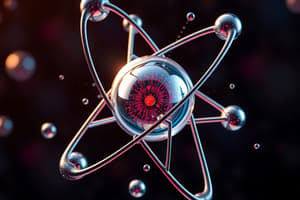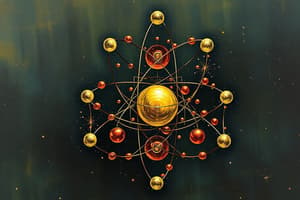Podcast
Questions and Answers
How many total atoms are represented in the formula 3CaCl₂?
How many total atoms are represented in the formula 3CaCl₂?
- 6
- 12
- 15
- 9 (correct)
What is the total number of sulfur atoms in 4K₂SO₄?
What is the total number of sulfur atoms in 4K₂SO₄?
- 4 (correct)
- 12
- 8
- 2
When counting atoms in 5Fe₂O₃, what is the total number of oxygen atoms?
When counting atoms in 5Fe₂O₃, what is the total number of oxygen atoms?
- 30
- 10
- 5
- 15 (correct)
How many hydrogen atoms are there in the expression 3H₂SO₄?
How many hydrogen atoms are there in the expression 3H₂SO₄?
In the molecule 2C₂H₆, how many total carbon atoms are present?
In the molecule 2C₂H₆, how many total carbon atoms are present?
What is the main characteristic of covalent bonds as described?
What is the main characteristic of covalent bonds as described?
Which of the following is true about the valence electrons indicated by an element's group number?
Which of the following is true about the valence electrons indicated by an element's group number?
What happens to the metal atom in an ionic bond?
What happens to the metal atom in an ionic bond?
Which pair of elements would most likely form an ionic bond?
Which pair of elements would most likely form an ionic bond?
What characteristic distinguishes ionic compounds from covalent compounds?
What characteristic distinguishes ionic compounds from covalent compounds?
Which of the following statements accurately describes groups of elements and their valence electrons?
Which of the following statements accurately describes groups of elements and their valence electrons?
What is the primary reason that noble gases do not typically form bonds?
What is the primary reason that noble gases do not typically form bonds?
How do metals generally behave in terms of electron transfer in bonding?
How do metals generally behave in terms of electron transfer in bonding?
What distinguishes transition metals from main group elements regarding their valence electron configurations?
What distinguishes transition metals from main group elements regarding their valence electron configurations?
What defines an ion in the context of chemical bonding?
What defines an ion in the context of chemical bonding?
What is the purpose of adding coefficients in a chemical equation?
What is the purpose of adding coefficients in a chemical equation?
Which of the following is a correctly balanced equation?
Which of the following is a correctly balanced equation?
Which step is NOT included in the process of balancing a chemical equation?
Which step is NOT included in the process of balancing a chemical equation?
In the example reaction N₂ + 3H₂ → 2NH₃, how many hydrogen atoms are present in the products?
In the example reaction N₂ + 3H₂ → 2NH₃, how many hydrogen atoms are present in the products?
What is the first step in balancing a chemical equation?
What is the first step in balancing a chemical equation?
What is a crucial step in balancing a chemical equation?
What is a crucial step in balancing a chemical equation?
In the equation N₂ + H₂ → NH₃, which coefficients are necessary to balance it correctly?
In the equation N₂ + H₂ → NH₃, which coefficients are necessary to balance it correctly?
How do you check your work after balancing a chemical equation?
How do you check your work after balancing a chemical equation?
Which of the following equations is balanced correctly?
Which of the following equations is balanced correctly?
What mistake should be avoided when balancing chemical equations?
What mistake should be avoided when balancing chemical equations?
How many total atoms are present in the formula 3 C₆H₁₂O₆?
How many total atoms are present in the formula 3 C₆H₁₂O₆?
In the chemical equation 2 H₂ + O₂ → 2 H₂O, how many total oxygen atoms are involved in the reaction?
In the chemical equation 2 H₂ + O₂ → 2 H₂O, how many total oxygen atoms are involved in the reaction?
What is the total number of atoms in the formula 3 CaCl₂?
What is the total number of atoms in the formula 3 CaCl₂?
In the formula 4 K₂SO₄, how many sulfur atoms are there in total?
In the formula 4 K₂SO₄, how many sulfur atoms are there in total?
If the formula 5 Fe₂O₃ is given, how many total iron atoms are there?
If the formula 5 Fe₂O₃ is given, how many total iron atoms are there?
Flashcards
Chemical Bonding
Chemical Bonding
Atoms joining together to create new substances, like when hydrogen and oxygen combine to form water.
Valence Electrons
Valence Electrons
Electrons in the outermost shell of an atom, which are involved in bonding.
Groups 1 & 2 Valence Electrons
Groups 1 & 2 Valence Electrons
Elements in groups 1 and 2 on the periodic table have the same number of valence electrons as their group number. For example, lithium (Group 1) has 1 valence electron.
Ions
Ions
Signup and view all the flashcards
Metal Ions
Metal Ions
Signup and view all the flashcards
What is a Lewis dot diagram?
What is a Lewis dot diagram?
Signup and view all the flashcards
How is an Ionic Bond formed?
How is an Ionic Bond formed?
Signup and view all the flashcards
How is a Covalent Bond formed?
How is a Covalent Bond formed?
Signup and view all the flashcards
How do you determine the number of valence electrons?
How do you determine the number of valence electrons?
Signup and view all the flashcards
What are examples of ionic and covalent bonds?
What are examples of ionic and covalent bonds?
Signup and view all the flashcards
Subscript in a chemical formula
Subscript in a chemical formula
Signup and view all the flashcards
Coefficient in a chemical formula
Coefficient in a chemical formula
Signup and view all the flashcards
Chemical equation
Chemical equation
Signup and view all the flashcards
Reactants
Reactants
Signup and view all the flashcards
Products
Products
Signup and view all the flashcards
What is a balanced chemical equation?
What is a balanced chemical equation?
Signup and view all the flashcards
What is a coefficient in a balanced equation?
What is a coefficient in a balanced equation?
Signup and view all the flashcards
How do you balance a chemical equation?
How do you balance a chemical equation?
Signup and view all the flashcards
Why can't you change subscripts in balancing?
Why can't you change subscripts in balancing?
Signup and view all the flashcards
What principle is upheld when balancing equations?
What principle is upheld when balancing equations?
Signup and view all the flashcards
Balancing chemical equations
Balancing chemical equations
Signup and view all the flashcards
Coefficients in chemical equations
Coefficients in chemical equations
Signup and view all the flashcards
Subscripts in chemical equations
Subscripts in chemical equations
Signup and view all the flashcards
Balancing atoms in a chemical equation
Balancing atoms in a chemical equation
Signup and view all the flashcards
Reactants in a chemical equation
Reactants in a chemical equation
Signup and view all the flashcards
What do subscripts in chemical formulas represent?
What do subscripts in chemical formulas represent?
Signup and view all the flashcards
What do coefficients in chemical formulas represent?
What do coefficients in chemical formulas represent?
Signup and view all the flashcards
What are reactants in a chemical equation?
What are reactants in a chemical equation?
Signup and view all the flashcards
What are products in a chemical equation?
What are products in a chemical equation?
Signup and view all the flashcards
What is a chemical equation?
What is a chemical equation?
Signup and view all the flashcards




